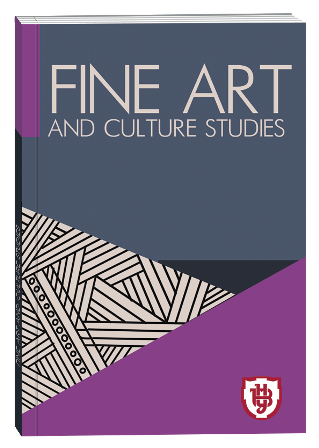THE FOLK DANCES OF THE MIDDLE AGES THE FOUNDATION OF BALLROOM CHOREOGRAPHY
DOI:
https://doi.org/10.32782/facs-2024-1-23Keywords:
domestic dances, ballroom choreography, medieval culture, king, farandole, branle.Abstract
Today, detailed study of the enduring constructs within culture that influence the mechanism of creating and the modes of existence of various forms of dance art proves to be exceptionally relevant. Each historical epoch cultivated certain forms of choreography, shaping fundamental dominants and canons that influenced its development. Understanding the nature, place, and role of ballroom dance, the evolution of which exhibits both synchronic and diachronic manifestations, correlates, and consequences, directs towards the exploration of the uniqueness of its origin. Therefore, it is scientifically expedient to focus attention on elucidating the issues of the emergence of ballroom choreography, determining its genetic roots, or activating it in one historical period or another. Purpose of the work. To analyze the comprehensive picture of the formation of ballroom choreography in the sociocultural space of medieval Europe. The paper examines dominant examples of domestic choreography represented in the dance culture of the Middle Ages. Based on numerous literary sources, the specifics of the choreographic tradition of that time are explored. Shedding light on various aspects of the investigated issues, we employ various scientific methods: analytical (in studying art, philosophical, and cultural approaches to the outlined topic); historical (in researching the genesis and reception of ballroom choreography); cultural (in examining the function that dance culture served in the spiritual life of the contemporary era); art historical (analysis of the lexical and stylistic specifics of ballroom dances), semiotic (analysis of the sign structure of dance, semantics of dance patterns). Scientific novelty. The article represents the first attempt to address a wide range of cultural issues related to the genesis, semantic content, and essence of ballroom dance, its role, and significance in the self-expression of certain subjects of medieval society. Conclusions. Dance is a reflection of a specific era and fulfills the social order of a particular society. The Middle Ages played an important role in the development of choreographic culture. Most courtly dances of that period are folk domestic patterns, adapted and modified according to the norms, customs, and rules of court etiquette.
References
Благова Т. О. Формування теоретичних основ хореографічної освіти в контексті танцювальної культури античності. Педагогіка і психологія професійної освіти. 2015. № 4–5. С. 148–157.
Волчукова В. М. Проблеми розвитку і роль ритуального танцю у ранньохристиянській культурі : автореф. дис. на здобуття наук. ступеня канд. мистецтвознавства : 17.00.01 «Теорія і історія культури». Харків, 2002. 19 с.
Крись А. І. Генеза та розвиток сценічного бального танцю (VIII ст. до н.е. – XVI ст. н.е.). Вісник Національної академії керівних кадрів культури і мистецтв. 2020. Вип. 2. С. 151–156.
Цвєткова Л. Ю. Придворні танці в культурі західноєвропейського високого середньовіччя. Танцювальні студії. 2020. Т. 3, вип. 1. С. 10–23.
Alford V. The Farandole. Journal of the English Folk Dance and Song Society. 1932. issue 1, No. 2. pp. 18–33.
Andrews T. Magickal dance: your body as an instrument of power : lewellyn's practical guide to personal power. Saint Paul : Llewellyn Publication, 1995. 240 р.
Arbeau Thoinot. Orchesography. Transl. from French by Mary Stewart Evans. Great Britain : Dover, 1967. 266 p.
Borchers D. Dance in Christian Worship. Currents in Theology and Mission. 1990. issue 17, No. 3. P. 207–213.
Brummel J. A. From Sin to Sensation : The Progression of Dance Music from Medieval Period Through the Renaissance. The Research and Scholarship Symposium. 2016. pp. 32–39.
Hudler M. The Body Speaks of Sin : The Voice of Dance in the Middle Ages. Interdisciplinary Humanities. 2004. issue 21, No. 1. pp. 20–29.
Judith L. H. Dance and Religion. The Encyclopedia of Religion. 2nd ed. New York, 2005. Vol. 4. pp. 2134–2143.
Kassing G. History of Dance : An Interactive Arts Approach. Gayle : Human Kinetics Pub, 2007. 309 p.
Mullally R. The Carole : A Study of a Medieval Dance. Aldershot : Ashgate, 2011. 172 p.
Noverre J.-G. Letters on Dancing and Ballets. Transl. from French by Cyril W. Beaumont. Publisher : Dance Books Ltd, 2010. 169 p.
Philippe de Remi`s. La Manekine : Text, Translation, Comentary. Transl. from French by Irene Gnarra. New York W.W. Norton, 1988. 457 p.
Sachs C. World History of the Dance. New York W.W. Norton, 1963. 516 p.
Wood M. Some historical dances – twelfth to nineteenth century. London : Princeton Book Company Publishers, 1952. 184 p.
The carole. Medieval Dance Online. URL : https://www.medievaldanceonline.co.uk/the-carole (дата звернення 08.12.2023).







